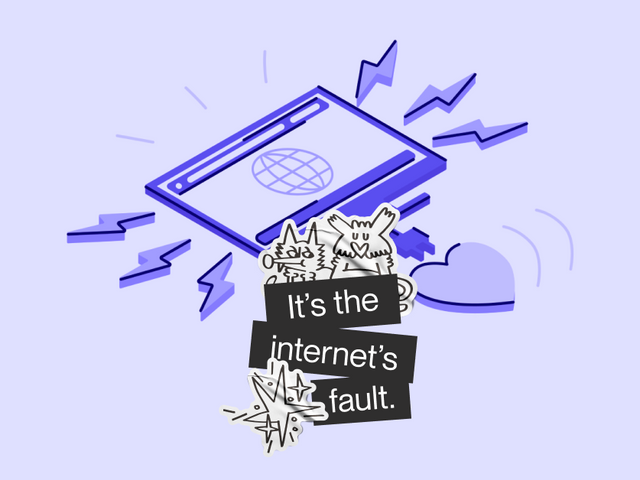The internet has changed almost every aspect of our lives—#nonprofit life is no exception.
Ah the internet. For a lot of us, life would be almost unliveable without it. And, for something that has been around for general use for about 30-ish years (1991 to be exact), that’s an impressive feat.1 The internet has, in some way or another, infiltrated almost every aspect of our lives. There are the obvious changes: instant access to a world of information, online shopping, how we communicate, how we watch TV, and how we work. There are the welcome changes—we’d be lost without you, Google maps. and the disruptive changes. (Yeah, we’re looking at you, ChatGPT.) And then, there are the subtler changes that happened almost without us noticing—innovations such as productivity tools, constant connectivity, banking, and—you guessed it—fundraising.
Traditionally, nonprofits have been relatively slow at adopting new technology.2 Not because they don’t want to, but because investing in anything but the cause they’re fighting for has been (until recently) seen as a for-profit practice. Call it what you want—lack of funding, lack of support from leadership, misunderstanding of basic business practices by donors—but donors tend to favour nonprofits with low overhead and that makes investing in things like infrastructure harder for nonprofits to justify.
All this means that it has historically taken nonprofits longer to adopt new technologies—like the internet and everything that comes with it—that are normally developed for, and quickly adopted by, the for-profit sector. Why? Well, the for-profit sector can invest in the latest tech. no questions asked, especially if it’s going to get results and save money in the long run.2 However, new technologies are rarely developed for, or adopted by, the nonprofit sector at a rate that would give them a competitive edge—a surprising fact given that nonprofits are the third largest employer in the United States and represents 5.7% of it’s GDP.3
Thankfully, all this is changing.
Today, nonprofits are investing in digital solutions to improve operations, facilitate donor and volunteer interactions, and increase the impact of their organizations. Which, unsurprisingly, has led to so pretty significant benefits for donors and volunteers.
Does technology help nonprofits? Yes. And it helps donors too.
A lot like the way the internet changed how we all shop for just about everything, it also changed how we “shop” for the right nonprofit.4 Wait wait wait. People don’t shop for nonprofits… Do they? Well, these days, yes. Yes they do.

The internet has its flaws (lack of equal access, cultural and linguistic bias, etc.), but, like the nonprofit organizations using it, it also does a lot of good. It gives those who can access it a world of information, the ability to independently drive social change, the tools to help communities around the world, the power to meet and communicate with like-minded people, and it gives us all of that without the need for an established nonprofit.
The roles have changed from one in which individuals needed nonprofits to connect to social causes, to nonprofits needing to connect with individuals who can help them deliver on their mission. - Can nonprofits lead change in the digital age?
So, pre internet: we needed to connect with nonprofits to help us help others. Today: nonprofits need to connect with us to help them help others.
The internet has made it easier than ever to spend our money and to research options before we spend it. The nonprofit sector is no different. There are over 10 million nonprofits around the world for donors and volunteers to choose from.5 This means that nonprofits and donors both have access to more choice and more information—we’re just doing different things with it. Donors are using it to research, understand and choose which nonprofits to support. Nonprofits are using it to attract, keep and build long-term relationships with donors.4,6
The technology the internet inspired.
From donor management to fundraising to event planning, the internet has inspired a lot of technology and software that are changing the way nonprofit organizations work.
Websites have made it easier for people to learn about the various nonprofits out there and compare them with other nonprofits doing similar work.
Crowdfunding platforms like GoFundMe have made small, grassroots movements legitimate, while making us all more comfortable donating online.
Fundraising platforms (Like Zeffy, the only fundraising platform for nonprofits that is 100% free.) are giving nonprofits access to technology and software designed to help them develop fundraising campaigns that are more likely to resonate with their supporters.
Free technologies like Google Analytics help nonprofit organizations collect and analyze data so they can understand their donors.
Social media has made it easier to find and connect with new and current donors, share stories and raise awareness.
Phew. Okay, let’s break a few of those down.
How the internet makes comparing and choosing nonprofits easier.
Before the internet we may have given to our kids’ school because, well, our kids went there or to World Wildlife Fund because we saw their ads on TV. AKA, those were the nonprofits we knew about. Today, thanks to the internet, we can easily research and compare nonprofits from anywhere that are working towards a cause we believe in.
Sites like GiveWell, Charity Navigator, and CharityWatch give donors a ton of information on nonprofits. Yes, some of it is problematic and has arguably created unrealistic expectations in terms of how nonprofits should invest the money they are given, but they have also helped nonprofits streamline their messaging and become leaders in transparency while helping donors connect with nonprofits around the world.
How the internet changed the way we give.
Online giving has grown on average 9% per year for the last 20 years.7
Online engagement is a critical component of a nonprofit organization’s communication, fundraising, advocacy, and stewardship strategy. 2021 showed the vital role that online engagement and giving play in donors’ lives and nonprofits’ goals. We continue to see that the digital landscape is transforming the social good sector. - Online Giving Trends.
Simply put, more and more of us are making our donations online every year and that trend isn’t slowing down and time soon. And, even better, those who do choose to give online are “younger, earn higher incomes, donate more on their first time, and continue to give more over a length of time compared to offline donors. It is also easier to convert and get online donors to adopt offline methods. The vice versa is not as simple.”8
So, not only has the internet helped more of us help others by making it easier to donate, it has helped nonprofits attract younger donors and make it easier to actually keep them around.
Thank you internet.
How the internet changed how nonprofits fundraise.
Fundraising. For nonprofits, it’s one of the few ways of actually raising the money they need to do they work they need to do. And (thank goodness) the internet has made fundraising a whole lot simpler.9
Okay, get ready, this is where we shamelessly plug Zeffy.

Nonprofits don’t necessarily need the internet to operate but, these days, it sure helps. The problem is that, aside from social media platforms and Google Analytics, there isn’t a lot of free software on the internet designed to support nonprofits. And that means that online fundraising platforms (along with their hidden fees and transaction fees and random other fees that can represent anywhere from 1.9-10% of every donation) have become another expense most nonprofits just can’t afford but don’t really have any other choice so use money that could have reasonably gone towards actually making a difference.
And this is where Zeffy comes in. We believe that nonprofits are helping change the world for the better but they’re being limited by a system that was not designed for them to thrive. So, we're breaking the mould to help them by offering free fundraising and donor management software. And, when we say free, we mean it. No hidden fees. No platform fees. No premium fees. We don’t charge anything and we never will.
Our tools allow nonprofits to collect donations, communicate with donors, plan events and sell tickets online, manage their volunteers, set up an online store, and a lot more—all in one place. (Thank you internet.)
But equal access to technology designed with nonprofits in mind is only part of the battle. Zeffy also believes that the information found on the internet should be available to anyone who wants it. So, we’re working hard to give nonprofits access to the knowledge they need to help them achieve their mission by making our blog and webinar series free and available to anyone.
Okay, so, internet + fundraising = better. Up next: connecting with donors.
The internet definitely changed the way nonprofits connect with donors.
This one shouldn’t be all that surprising. Arguably one of the internets biggest impacts on our lives is how it changed the way we connect with each other. So, it only makes sense that it has also changed that way nonprofits connect with their donors.
The internet has revolutionized—yes revolutionized—a nonprofit’s ability to stay in touch with donors. Nonprofits can now communicate with their donors through email, chat, social media, and text. That’s not to say direct snail mail and good old fashion phone calls don’t still work, because they do. But, being able to pre-program emails, instantly chat with donors, reach out via Instagram, and personalize it all with the data from past conversations is a ridiculously powerful time-saving tool.
Plus, the average retention rate for online-only donors is 23% in the first year and 64% for long term donors.7 What’s not to like about those numbers?
For now, email is by far the most popular form of communication for nonprofits and allows them send personalized messages to their donors, update donors on the organization’s progress, and thank donors for their contributions. By analyzing donor data, nonprofits can even tailor their communications to the specific interests. And, to top it all off, this personalized approach can increase donor engagement and conversion by up to 25%. (And, Zeffy can help you do all of that. For free. Just saying.)
For nonprofits, social media can be a good thing.
Engagement and retention. You probably hate these two words. But, these days they are two on the most important words out there. (Stupid internet.) Successful brands (including nonprofits) know that engaging donors is the best way to retain them. And social media is the cause and solution.
Nonprofits can use social media to share their mission, tell their story, and showcase their impact. They can solicit donations, run fundraising campaigns, and engage with donors. And, most importantly, donors and volunteers can share their stories, showcase their impact, and act as ambassadors for your nonprofit or cause.
The benefits of social media don’t stop there. These addictive platforms can help nonprofits reach new audiences and raise awareness about their cause, and … influencers … We know, we know. But they work. And nonprofits have a leg up here: being a not-for-profit means influencers might actually donate their time and followers. And, with a possible increase in engagement of around 16%, it’s worth looking into.10
The concept of brands and organizations seeking out endorsements is nothing new, but what is new is how it’s done in the age of the internet. In short, celebrities and influencers now have more reach and engagement with audiences than ever before. And with a single tweet, snap or social media update, it can make the world of a difference for a charity looking to make a positive impact in the world today. - 5 Ways the Internet is Changing the World of Charity and Donations.
Nonprofits can use social media (and an influencer or two) to get their message out there and reach a wider and younger audience.
The Future of Nonprofit Fundraising.
The internet isn’t going to stop impacting our lives anytime soon. Technology is going to continue to evolve. And, the nonprofit sector will too. The good news is: nonprofits (and the world in general) are more accepting of this than ever before. But, how can a nonprofit, with limited resources, stay up-to date? Well, a good place to start is staying informed.
One of the biggest emerging trends in nonprofit fundraising is the use of social media platforms.
Wait. Isn’t this already a trend? Yes. But, social media platforms have an annoying habit of updating everything ALL THE TIME. So, as social media platforms continue to evolve, nonprofits will need to adapt their strategies to stay relevant and continue to engage their donors and audiences.
Another emerging trend is the use of artificial intelligence (AI) and machine learning. Nonprofits can already use AI for a lot. And we mean a lot.
So much that we’ve written multiple how-to articles to help you and your nonprofit get the most out of ChatGPT.
In addition to leveraging emerging trends, nonprofits need to continue to focus on sustaining donor relationships. Donor retention is critical for nonprofit success and is often more cost-effective than finding new ones.
In short: as the nonprofit fundraising landscape continues to evolve, nonprofits should to.
So, what’s the internet mean for the future of nonprofits?
Nonprofits need to realize that the internet has made the collective we the gatekeepers for social change and transformed nonprofits into platforms to connect those who care with those in need. To accept this and continue to adapt, nonprofits need to embrace new tools and become the social change platform their donors and volunteers are expecting them to be.6
oxio would like to thank Zeffy and writer David Purkis for sharing this insightful article. Check out Zeffy for all your nonprofit needs!
- History of the Internet.
- The Impact of Digital Transformation on Nonprofits.
- 26 Incredible nonprofit statistics [2023].
- Charities changed by technology.
- 50 Nonprofit Facts and Statistics.
- Can nonprofits lead change in the digital age?
- Online Giving Trends.
- Online vs. Offline Fundraising.
- How Technology is Revolutionizing Nonprofit Fundraising: A Comprehensive Guide.
- Does Influencer Marketing Really Pay Off?
- 5 Ways the Internet is Changing the World of Charity and Donations.








